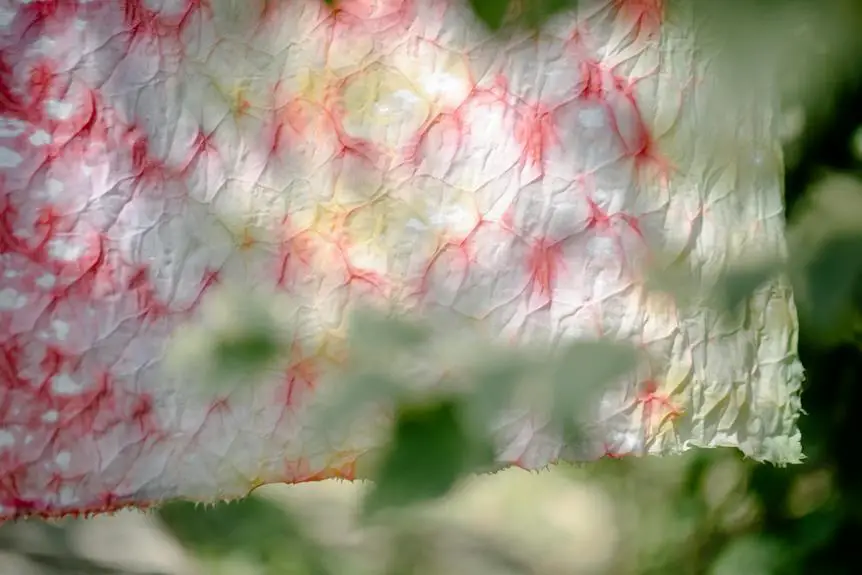When you wash your fabrics, dealing with creasing can be a frustrating afterthought. You might think simply tossing them in the dryer is enough, but there are more effective strategies to consider. By understanding the right detergent choices, washing methods, and drying techniques, you can minimize wrinkles significantly. However, if creases still appear, knowing how to tackle them becomes essential. Are you aware of the best tools and tips that could save you time and effort? The next steps might surprise you.
Table of Contents
Key Takeaways
- Wash fabrics in cold water to preserve color and texture, reducing the likelihood of creasing.
- Avoid overloading the washer to allow proper movement and agitation, minimizing wrinkles.
- Shake garments gently before air drying to reduce tension in fibers and prevent creasing.
- Use the appropriate iron temperature and steam function for effective wrinkle removal while avoiding fabric damage.
Understanding Fabric Types
To effectively tackle creasing after washing, you first need to understand the different types of fabrics you're working with. Each fabric reacts differently to washing and drying, which can significantly influence how much creasing you'll encounter.
For instance, cotton tends to wrinkle easily due to its natural fibers, while synthetic fabrics like polyester are more wrinkle-resistant. You should also be aware of blends; for example, cotton-polyester blends offer a balance between comfort and durability, often resulting in less creasing than pure cotton.
Linen, on the other hand, is beautiful but notorious for its tendency to crease, requiring extra care during washing. Silk is another fabric you'll want to handle with caution, as it can lose its sheen and become misshapen if not treated properly.
Knowing the fabric type helps you choose the right washing methods and drying techniques to minimize creasing.
Best Washing Practices
To keep your fabrics looking fresh and minimize creasing after washing, you need to follow some best practices.
Choosing the right detergent, using cold water, and avoiding overloading your washer are key steps.
Let's explore how each of these points can make a difference.
Choose Appropriate Detergent
Choosing the right detergent not only enhances cleaning power but also minimizes the risk of creasing in your fabrics. When selecting a detergent, look for one specifically formulated for the type of fabric you're washing. For delicate items, a gentle detergent can prevent damage and reduce wrinkles.
You also want to consider the detergent's concentration. Highly concentrated detergents require less product per load, which can help maintain fabric integrity and reduce the likelihood of buildup that may cause creasing. Opt for low-sudsing formulas, as they rinse out more easily and can lead to less residue left on the fabric.
Avoid using bleach or harsh chemicals unless absolutely necessary, as these can weaken fibers and lead to creasing over time.
Additionally, make sure to follow the manufacturer's instructions on detergent usage for your washing machine. Using too much detergent can leave a film on your clothes, which may contribute to wrinkles.
Use Cold Water
Using cold water when washing your fabrics not only helps preserve their color and texture but also significantly reduces the chances of creasing. Hot water can cause fibers to contract and become wrinkled, leading to the frustrating creases you want to avoid. By opting for cold water, you keep the fibers relaxed and maintain their original structure.
When you wash in cold water, you also minimize the risk of damaging delicate fabrics. Many materials, such as silk or lace, are sensitive to temperature changes. Cold water is gentle, ensuring your garments stay looking fresh and new longer.
Another benefit of washing in cold water is that it's more energy-efficient. You'll lower your utility bills while being kinder to the environment. Plus, cold water is effective in removing stains when combined with the right detergent, so you don't have to sacrifice cleanliness for fabric care.
Avoid Overloading Washer
Overloading your washer can lead to excessive creasing, as the fabric doesn't have enough space to move freely during the wash cycle. When you stuff the washer beyond its capacity, clothes can become tangled and squished together. This tight packing restricts movement, causing friction and resulting in stubborn wrinkles.
To prevent this, always follow your washer's recommended load capacity. A good rule of thumb is to fill the drum to about three-quarters full, allowing enough room for the fabrics to agitate. If you're washing bulky items like blankets or towels, consider doing them in separate loads. It might take a little more time, but your clothes will thank you.
Additionally, don't forget to distribute the load evenly. Placing heavier items on one side can throw off the balance, making it harder for your washer to clean effectively. By keeping your loads light and balanced, you'll minimize creasing and ensure a thorough wash.
Drying Techniques to Avoid Wrinkles
To keep your fabrics looking fresh and wrinkle-free, try shaking them out gently before hanging or laying them flat to dry. This action helps to release some of the tension in the fibers, reducing the likelihood of creases. You can also consider the following drying techniques to further prevent wrinkles:
| Drying Technique | Description |
|---|---|
| Air Drying | Hang garments on a clothesline or hanger. Ensure they're spaced out to allow airflow. |
| Tumble Dry on Low Heat | Use a dryer with low heat settings, and remove clothes while they're still slightly damp. |
| Flat Drying | Lay delicate fabrics flat on a clean, dry surface, reshaping them as needed to avoid stretching. |
| Use a Fabric Softener | Adding fabric softener during the wash can help fabrics relax and reduce wrinkles when drying. |
Ironing Tips for Smooth Fabrics
When it comes to ironing, choosing the right iron can make a big difference in achieving smooth fabrics.
You'll want to use proper techniques to ensure you're not just pushing the wrinkles around.
Let's explore how to select the best iron and master effective ironing methods.
Choosing the Right Iron
Selecting the right iron can make all the difference in achieving smooth, crease-free fabrics. When you're tackling wrinkles, an effective iron suits your needs and the types of fabrics you'll be working with. Here are some features to consider when choosing an iron:
- Steam Function: Look for an iron that produces a strong steam output, as it helps relax fibers and eliminate wrinkles more effectively.
- Soleplate Material: Opt for a non-stick soleplate, such as stainless steel or ceramic, which glides easily over fabrics and prevents sticking.
- Weight: A heavier iron often provides better pressure, making it easier to smooth out stubborn wrinkles. Choose one that feels comfortable in your hand.
- Temperature Control: Ensure you can adjust the temperature settings for different fabrics, from delicate silks to thicker cottons, to prevent damage.
Proper Ironing Techniques
Mastering proper ironing techniques is key to achieving smooth, wrinkle-free fabrics quickly and efficiently. Start by setting your iron to the appropriate temperature based on the fabric type. Always check the care label for guidance. For delicate fabrics like silk, use a lower setting, while cotton can handle higher heat.
Before you begin, ensure your fabric is slightly damp. If it's dry, mist it lightly with water. Lay the fabric flat on an ironing board, and start with the collar, cuffs, or any smaller areas first. Move the iron in smooth, straight strokes; avoid pressing down too hard, as this can create new wrinkles.
For larger sections, work from the top down. Always lift the iron rather than sliding it across the fabric to prevent unwanted creases. If you're dealing with stubborn wrinkles, consider using steam or a pressing cloth for extra protection.
Alternatives to Ironing
If you're looking to smooth out wrinkles without an iron, there are several effective alternatives that can save you time and effort.
These methods can bring your clothes back to life quickly, so you won't have to stress about creases ruining your look.
- Steam from the Shower: Hang your wrinkled clothes in the bathroom while you take a hot shower. The steam will help release the wrinkles.
- Damp Towel: Place a damp towel over the wrinkled fabric and use your hands to smooth it out. The moisture will help relax the fibers.
- Hair Dryer: Use a hair dryer on a low setting. Hold it a few inches away from the fabric and move it back and forth to eliminate wrinkles.
- Wrinkle Release Spray: Invest in a commercially available wrinkle release spray. Lightly mist your clothes and gently tug on the fabric to smooth out the wrinkles.
These alternatives can be just as effective as ironing and can fit seamlessly into your routine.
Preventative Measures for Future Loads
To keep your fabrics looking fresh and wrinkle-free after washing, it's important to adopt some preventative measures during your laundry routine.
Start by sorting your laundry properly. Separate heavier items, like towels and jeans, from lighter fabrics, as the weight can cause creasing during the wash.
Use a gentle cycle for delicate items, and don't overload your washer. A full load may seem efficient, but it can lead to more wrinkles because clothes won't have room to move freely. Additionally, consider using cold water, which is gentler on fabrics and reduces the chances of creasing.
When it comes to drying, opt for a lower heat setting if you're using a dryer. High heat can set wrinkles in place. If you can, remove clothes while they're slightly damp and hang them up to air dry. This helps maintain their shape and reduces creases.
Lastly, take care when folding or storing clothes. Avoid cramming them into drawers or closets. Instead, give them space to breathe, which can significantly reduce creasing in future loads.
Implementing these simple strategies will keep your fabrics looking crisp and fresh longer.
Frequently Asked Questions
Can Fabric Softeners Prevent Creasing After Washing?
Fabric softeners can help reduce creasing by coating fibers, making them smoother and less prone to wrinkles. However, they're not a complete solution; you should still follow proper washing and drying techniques for best results.
How Does Water Temperature Affect Fabric Creasing?
Water temperature impacts fabric creasing significantly. Using hot water can relax fibers, reducing wrinkles, while cold water may tighten them, leading to more creasing. Adjusting temperatures helps you achieve smoother, fresher-looking fabrics after washing.
Is It Safe to Tumble Dry Delicate Fabrics?
It's generally not safe to tumble dry delicate fabrics. Instead, you should air dry them to maintain their shape and texture. Tumble drying can cause shrinkage, damage, or even distortion in fragile materials.
Do Certain Detergents Reduce Wrinkles in Fabrics?
Certain detergents can help reduce wrinkles in fabrics. They often contain ingredients that soften fibers, making them less prone to creasing. When you choose your detergent wisely, you'll notice smoother, more presentable clothes after washing.
What Fabrics Are Most Prone to Creasing After Washing?
Certain fabrics like cotton, linen, and rayon are more prone to creasing after washing. To minimize wrinkles, consider using blends or synthetic materials, which often resist creasing better than their natural counterparts.
- Why Open-Weave Scrim Is the Secret to Stunning Event and Canopy Designs - June 26, 2025
- Creating Large-Scale Art Installations With Scrim Fabric - June 26, 2025
- Scrim Fabric in Upholstery: Understanding Its Use as a Backing Material - June 26, 2025






